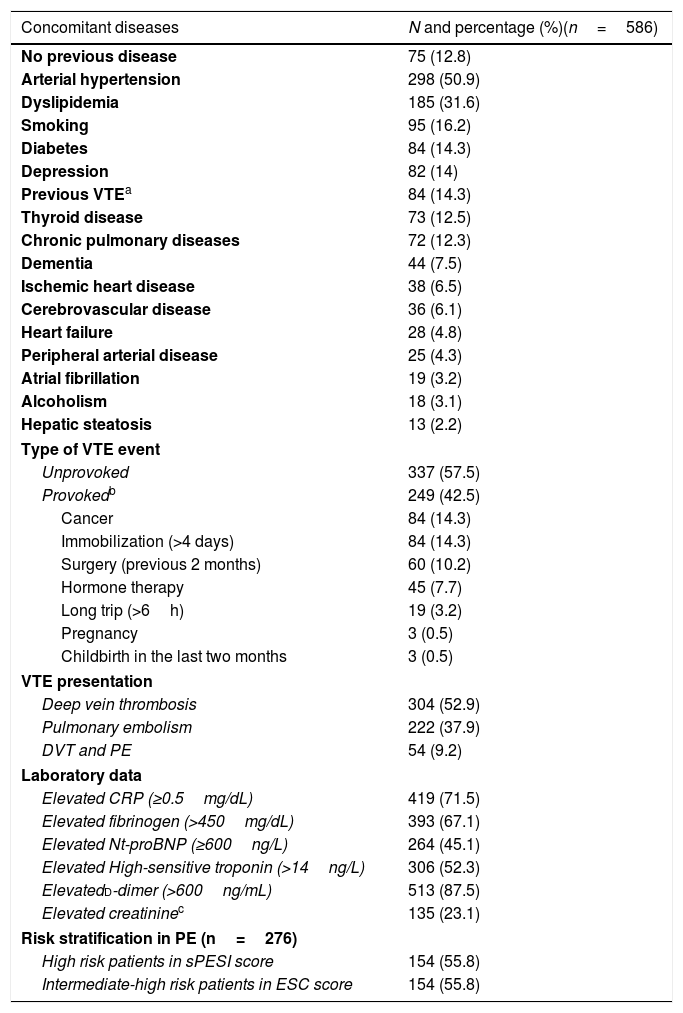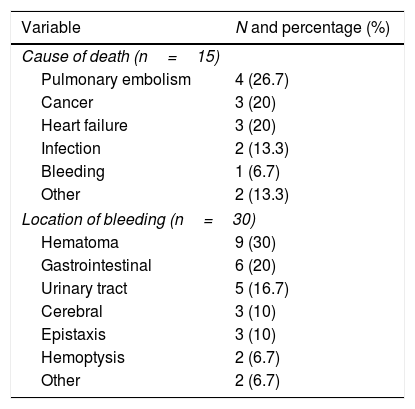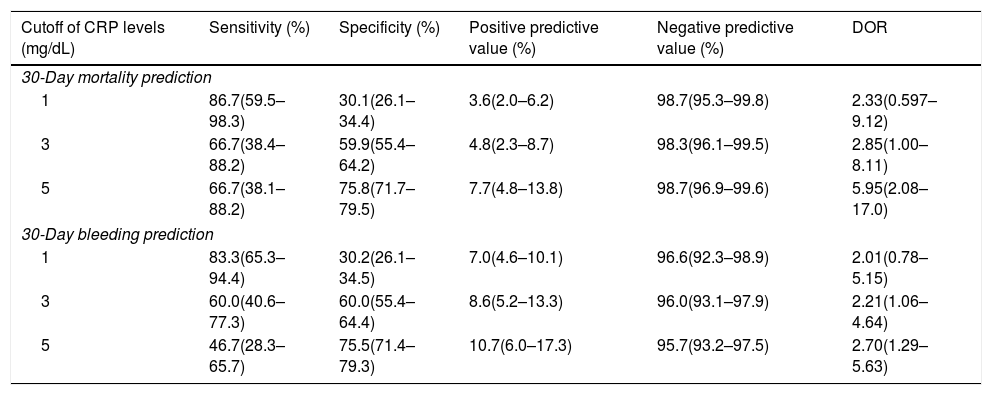The association of on-admission CRP and early adverse outcomes in acute venous thromboembolism (VTE) has not been investigated. We hypothesized that increased on-admission CRP levels would correlate with adverse outcomes in patients with acute VTE.
MethodIn this prospective observational study, consecutive patients with acute VTE were enrolled and CRP levels were measured within the first 24h after diagnosis. Mortality, bleeding and recurrence were recorded during a 30-day follow-up.
Results586 patients were included. Higher CRP levels were found in patients with mortality (7.5 vs 4.0mg/dL; p=0.01) and bleeding (7.8 vs 3.9mg/dL; p=0.03). Multivariable logistic regression showed that CRP levels >5mg/dL were associated with higher mortality (OR 6.25; 95% CI, 2.1–18.6) and bleeding (OR 2.7; CI 95% 1.3–5.7). These results were independent to ESC risk score and simplified PESI score for mortality prediction. The predictive capacity of CRP showed an area under the ROC curve – AUC – of .7 (CI 95% .56–.85) for mortality and .65 (CI 95% .54–.75) for bleeding. The prognostic capacity of the ESC risk score and simplified PESI score was improved after adding the CRP cutoff of 5mg/dL (AUC of .87 CI 95% .79–.95).
ConclusionOur findings suggest that on-admission CRP level may be a simple, widely available and valuable biomarker to identify high-risk VTE patients for early mortality and bleeding. CRP ≥5mg/dL was independently associated with 30-day VTE related death and bleeding.
La asociación de la medición de PCR al ingreso y las complicaciones precoces en la enfermedad tromboembólica venosa (ETV) aguda no ha sido evaluado. Nuestra hipótesis es que los niveles elevados de PCR al ingreso podrían estar correlacionados con complicaciones precoces en pacientes con ETV aguda.
MétodosEstudio observacional prospectivo, en el que se incluyeron pacientes consecutivos con ETV aguda en los que se midió la PCR en las primeras 24h del diagnóstico. La mortalidad, el sangrado y la recurrencia fueron registrados durante el seguimiento a 30 días.
ResultadosSe incluyeron 586 pacientes. Se encontraron niveles más elevados de PCR en pacientes que fallecieron (7,5 vs. 4mg/dl; p=0,01) y que sangraron (7,8 vs. 3,9mg/dl; p=0,03). Una regresión logística multivariante mostró que niveles de PCR>5mg/dl se asociaron significativamente con mayor mortalidad (OR: 6,25; IC 95%: 2,1-18,6) y sangrado (OR: 2,7; IC 95%: 1,3-5,7). Estos resultados fueron independientes de las escalas pronósticas de mortalidad ESC y PESI simplificada. La capacidad predictiva de la PCR mostró un área bajo la curva (ABC) ROC de 0,7 (IC 95%: 0,56-0,85) para mortalidad y 0,65 (IC 95%: 0,54-0,75) para sangrado. La capacidad pronóstica de las escalas pronósticas ESC y PESI simplificada mejoró de forma significativa al añadir el punto de corte de PCR>5mg/dl (ABC de 0,87; IC 95%: 0,79-0,95).
ConclusiónLa medición de PCR al ingreso puede ser un marcador sencillo y ampliamente disponible para identificar a pacientes con ETV aguda y alto riesgo de mortalidad y sangrado precoces. Niveles de PCR≥5mg/dl se asociaron de forma independiente con mayor mortalidad y sangrado a 30 días en pacientes con ETV aguda.
Artículo
Comprando el artículo el PDF del mismo podrá ser descargado
Precio 19,34 €
Comprar ahora










